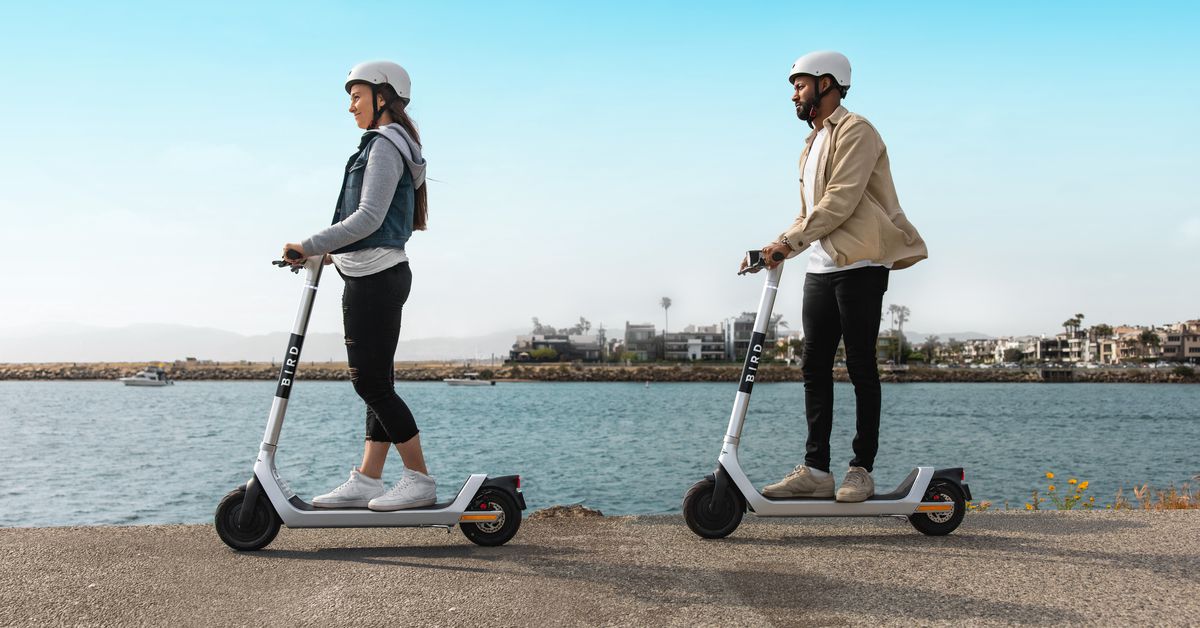Bird announces its third-generation electric scooter with automatic emergency braking
Source: The Verge added 27th May 2021Bird is out with a new electric scooter that’s designed to be the Santa Monica, California-based company’s most durable and sustainable vehicle yet.
The Bird Three scooter has a longer wheelbase, a dual-sensor throttle, and a “triple braking system” with dual independent handbrakes and an “autonomous emergency braking” system that the company claims is an industry-first.
But specifications aside, the really interesting thing about the Bird Three is the company’s insistence on calling it a “micro-EV.” It’s a clear effort by Bird, which recently announced its intent to go public via a “reverse merger” with a special purpose acquisition company, or SPAC, to capitalize on the current momentum around electric vehicles.
With billions of dollars potentially on the line for the EV industry as part of President Joe Biden’s infrastructure plan, and legacy automakers pouring billions of their own money into the development of EVs, Bird sees an opportunity to align itself with the prevailing winds in the transportation sector.
“In the early days, these were really toys if I’m honest,” said Scott Rushforth, chief vehicle officer at Bird, of the company’s original Xiaomi-manufactured products. “We used off the shelf products that didn’t last as long as we’d like them to.”
But that’s changed with the development of more rugged and longer-lasting scooters, earning them the automotive grade title “micro-EV,” Rushforth said. “It really is an EV that’s been shrunken down into the micro form factor,” he added. “So I love that term and I think that it’s hopefully going to become part of the dialogue.”
One of the most important numbers to consider is the lifespan of each scooter. The more trips and miles a single scooter can cover, the better it is for scooter companies that have to recoup the cost of each vehicle before they can start making money. With the Bird Three, the company thinks it has its longest-lasting scooter yet.
That is partly why the company is staking a position against the use of swappable batteries. Other countries, like China, are embracing battery-swapping technology as a way to expand access to their electric vehicles. But Bird claims that “smaller and swappable batteries lead to higher overall manufacturing emissions and require more vehicle miles traveled to retrieve, replace, and recharge scooters.”
Instead, the Bird Three’s battery has a capacity of “up to 1 kWh,” which the company says means less frequent charging and more miles traveled on a fully charged battery “than any other shared scooter available today.” That’s a significant step above the Bird One scooter’s battery capacity of 473Wh, and about 150 percent more capacity than the Bird Two.
The Bird Three battery is built to outlast the scooter to which it’s attached, with a minimum of 14,000 miles and up to a 20,000-mile lifespan. That’s probably longer than the 24- to 36-month lifespan of the entire vehicle, Rushforth said. And it’s IP68 rated, meaning it’s sealed from any water and dust that may get into the scooter.
“You know what’s better than a swappable battery is a battery that you don’t really need to maintain,” he added.
The scooter can run over 200 diagnostic checks and can relay messages to Bird’s maintenance crew when repairs need to be made. And when there’s a problem that would make the scooter unsafe to ride, the automatic emergency braking will bring the vehicle to a stop. Rushforth likened it to regenerative braking in an electric vehicle, in which the vehicle comes to a stop when the driver takes their foot off the acceleration pedal.
The Bird Three will be deployed in only a handful of markets to start out, including Tel Aviv, Berlin, and New York City (which is kicking off its inaugural scooter sharing pilot in June). After that, the company will begin the process of swapping the new scooter for the older models that need to be retired — which could take a while.
“It doesn’t make any sense for us to recycle a vehicle that’s out there getting rides,” Rushforth noted. “That’s not very green to just like get rid of the vehicles before their lifespan has ended.”
brands: Built Chief Dual Durable First It longer Micro New One other PILOT Replace Scott triple Xiaomi media: 'The Verge' keywords: Sensor
Related posts
Notice: Undefined variable: all_related in /var/www/vhosts/rondea.com/httpdocs/wp-content/themes/rondea-2-0/single-article.php on line 88
Notice: Undefined variable: all_related in /var/www/vhosts/rondea.com/httpdocs/wp-content/themes/rondea-2-0/single-article.php on line 88
Related Products
Notice: Undefined variable: all_related in /var/www/vhosts/rondea.com/httpdocs/wp-content/themes/rondea-2-0/single-article.php on line 91
Warning: Invalid argument supplied for foreach() in /var/www/vhosts/rondea.com/httpdocs/wp-content/themes/rondea-2-0/single-article.php on line 91
